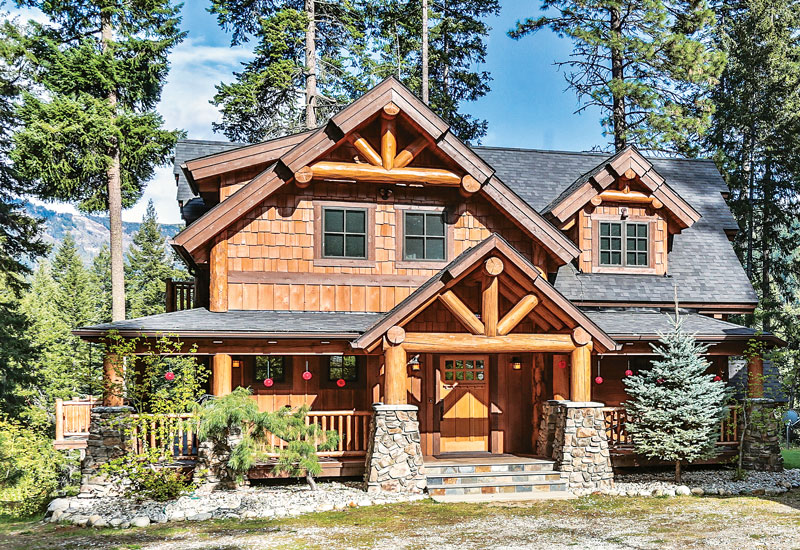Language is a funny thing. You’d think each word would have such a precise definition that if one person speaks it to another, both would interpret it in exactly the same way and have a clear picture of the topic at hand. Not so.
Take the word “hybrid,” for example. Technically speaking, it means “composed of elements of different or incongruous kinds.” But in the past 15 years or so, the term has been tossed around so much, referring to everything from vegetables to cars, that its meaning has gotten muddied. Housing is no exception.
Indeed, in the past seven to 10 years, we’ve talked about hybrid home construction extensively in the log and timber world.
But as a builder, when a client comes to me and says, “I want to build a hybrid log home,” I feel like I have to put on my detective’s hat and do a little investigation. Because to me, a hybrid is a something other than a full log structure masking itself in a log shell.
Is this what my client is asking for? Or in reality, is a log home with accents of mixed materials, such as timber framing, stone or poplar bark siding, really what he wants? Many of my customers who have the hybrid home idea in mind are looking for some type of insulated-log product. This is, in its truest sense, an actual hybrid log home.
Sometimes buyers think they want a hybrid when in reality what they want to do is build one portion of their home with logs and then join it with some other type of building system, like timber framing.
And then, there are still others who want to combine logs with timber accents, stone components and other materials, like cedar shakes on the gables. Sometimes buyers will refer to this as a hybrid when in reality what they want is a mixed-materials home.
It’s important to make these distinctions clear, because you will want your builder’s expectations of the scope of the project to align with your expectations of the outcome. You also want to be sure he or she is giving you a fair bid based on that true scope.
As an example, if you’re looking to conjoin log construction with a true timber framed structure, the project just got a lot more complex for your builder. Logs settle. Timber frames are static. At the point where they marry, your builder will have to come up with a plan to accommodate the movement and build a home that will be air-tight.
This complexity likely will increase cost. An alternative could be to stick with either the structural log or timber frame path, and then incorporate decorative elements of the other, such as log siding or non-structural timber trusses. Which brings us to mixed-materials homes.
In these cases, clients are seeking a home infused with a variety of building components. Some may be log, but you also will see an abundance of stone (not just encasing the foundation), bark, brick, cedar shake shingles (not just on the roof), cedar siding — even Hardie Board. Most often, these houses are supported with a framed or panelized building system and the materials — even the logs — are merely decorative.
But with the conglomeration of building components used, it’s easy to see why the word “hybrid” could be misapplied. So when you are explaining your dream home to your builder, be sure you’re speaking the same language. Illustrate your ideas with photos from magazines or product catalogs to avoid misinterpretation. Believe me — builders welcome the clarity; and a little extra communication will ensure you’re both headed down the right path.
Many of my customers who have the hybrid home idea in mind are looking for some type of insulated-log product. This is, in its truest sense, an actual hybrid log home. Sometimes buyers think they want a hybrid when in reality what they want to do is build one portion of their home with logs and then join it with some other type of building system, like timber framing. And then, there are still others who want to combine logs with timber accents, stone components and other materials, like cedar shakes on the gables.
Sometimes buyers will refer to this as a hybrid when in reality what they want is a mixed-materials home. It’s important to make these distinctions clear, because you will want your builder’s expectations of the scope of the project to align with your expectations of the outcome.
You also want to be sure he or she is giving you a fair bid based on that true scope. As an example, if you’re looking to conjoin log construction with a true timber framed structure, the project just got a lot more complex for your builder. Logs settle. Timber frames are static. At the point where they marry, your builder will have to come up with a plan to accommodate the movement and build a home that will be air-tight.
This complexity likely will increase cost. An alternative could be to stick with either the structural log or timber frame path, and then incorporate decorative elements of the other, such as log siding or non-structural timber trusses. Which brings us to mixed-materials homes. In these cases, clients are seeking a home infused with a variety of building components.
Some may be log, but you also will see an abundance of stone (not just encasing the foundation), bark, brick, cedar shake shingles (not just on the roof), cedar siding — even Hardie Board. Most often, these houses are supported with a framed or panelized building system and the materials — even the logs — are merely decorative.
But with the conglomeration of building components used, it’s easy to see why the word “hybrid” could be misapplied. So when you are explaining your dream home to your builder, be sure you’re speaking the same language. Illustrate your ideas with photos from magazines or product catalogs to avoid misinterpretation. Believe me — builders welcome the clarity; and a little extra communication will ensure you’re both headed down the right path.





